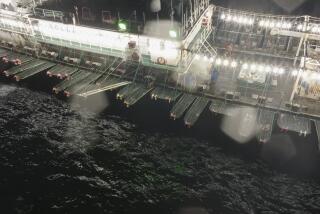The Artful Remains of Sailing Ships
- Share via
SALEM, Mass. — In the 17th, 18th and 19th centuries, wooden ships sailing the seven seas were never without them.
For sailors, they were the signature, the spirit of their barks, schooners and clipper ships protruding proudly from their bows.
Some were fanciful lions, others gigantic majestic eagles. There were Indian chiefs, knights in armor, comely maidens, U.S. Presidents, national heroes.
They were the folk art leaning forward from ships’ stems--figureheads adorning vessels, guiding the way through calm or stormy waters.
If the ship’s figurehead was damaged or destroyed in violent weather and turbulent seas, it was an ill omen feared by seafarers. The carved wooden figure would be repaired or replaced as soon as the ship entered its next port.
Ships’ carvers created thousands of figureheads in New England seaports from the early 1600s until the early 1900s, when sailing ships went the way of the dodo and figureheads became a lost art.
Today, only a few figureheads from sailing ships are left. Some remain in private ownership as garden and barn decorations; most are in museums.
Peabody Museum of Salem, on East India Square in this historic seaport, has one of the best figurehead collections in America--almost 100. Founded in 1799 by 22 sea captains, Peabody is one of the oldest maritime museums in the nation.
The bible of figureheads, “Shipcarvers of North America,” was written by M. V. Brewington, former Peabody curator. In his book, Brewington quotes Revolutionary War naval hero John Paul Jones describing the figurehead on a ship launched in 1782:
“A female crowned with laurels, right arm raised with forefinger pointing to heaven as if appealing to that high tribunal for the justice of the American cause. On her left arm was a buckler with a blue ground and 13 stars. The legs and feet of the figure were covered here and there with wreaths of smoke to represent the dangers and difficulties of the war.”
“Most figureheads were tossed aside when the old sailing ships were broken up. They weren’t considered to be of any particular value at the time,” noted Paul Winfisky, 42, assistant Peabody curator. “A few wound up in back yards of shipbuilding and shipowner families.”
Many of those figureheads have been donated to or purchased by museums during the last half-century. Some have been sold for as much as $50,000. “Figureheads pop up in strange places from time to time. Some wind up on auction blocks,” Winfisky said.
Peabody’s most recent acquisition came a few months ago when William Saltonstall, descendant of a Colonial New England family, presented the museum with a remarkably preserved figurehead from an unknown 19th-Century schooner. It’s a carving of a woman, dressed in classical Greek costume, white with gold trim, her head adorned with a gold crown.
“Saltonstall called and said he would like to give us the figurehead. It had been a barn ornament in the family for more than a century. He drove it to the museum in the back of a beach wagon,” Winfisky explained.
Among other figureheads from sailing ships exhibited at the Peabody is one of a feathered Indian clutching a tomahawk, poised to throw it from over his right shoulder. There’s a figurehead of a Scotch Highlander in kilts and one of Rembrandt from a ship called Rembrandt launched in 1876.
Many Peabody figureheads are women, some representing a shipowner’s wife or daughter. One shows a woman holding an ear of corn, another a woman clutching beads, yet another, a Victorian girl carrying a bouquet of flowers. Nude and semi-nude female figureheads were also quite popular. Several are in the Peabody collection.
Mystic Seaport in Connecticut is a 17-acre, 19th-Century complex of waterfront buildings, a shipyard, tall ships in the harbor and 400 historic small craft in warehouses. One of the most popular exhibits in this maritime museum is the Hall of Figureheads.
Among the 80 ship carvings displayed at Mystic is a rare dual figurehead called The Sisters, from a schooner launched in 1830. It shows two women in a dancing pose with garlands of flowers, long blonde hair, wearing identical blue dresses and pantalets.
Also displayed are a turbaned East Indian figurehead from the HMS Asia built in Bombay in 1824, a carved likeness of woman suffrage leader Belva Lockwood, an armored warrior in plumed helmet from the 1858 frigate Orlando, a Scotsman from the 1855 clipper ship Donald McKay, and a figurehead of Adm. David Farragut.
“One figurehead we wish we had is of Davy Crockett from the famous clipper ship by the same name built here in Mystic in 1853,” said Mystic Seaport’s curator William Peterson.
The National Maritime Museum in San Francisco has that figurehead. It is one of nine in the collection, the largest assemblage of ship carvings on the West Coast.
“There are only a few figureheads carved on the West Coast. As far as we know, none have survived. In our collection we have three figureheads from East Coast sailing ships and six from European ships,” said Ted Miles, National Maritime Museum historian.
More to Read
Sign up for The Wild
We’ll help you find the best places to hike, bike and run, as well as the perfect silent spots for meditation and yoga.
You may occasionally receive promotional content from the Los Angeles Times.






